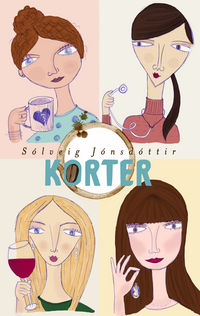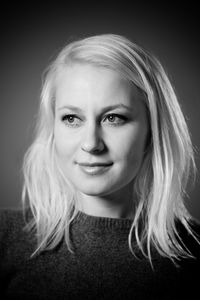Quarter
“I think that people in their twenties, guys as well as girls, can find parallels between themselves and the characters in the book,” says author Sólveig Jónsdóttir of her debut novel Quarter.
 “I think that people in their twenties, guys as well as girls, can find parallels between themselves and the characters in the book,” says author Sólveig Jónsdóttir of her debut novel Quarter (orig. Korter), a contemporary tale of four young women who all take shelter from their variously catastrophic lives at the same café in downtown Reykjavík.
“I think that people in their twenties, guys as well as girls, can find parallels between themselves and the characters in the book,” says author Sólveig Jónsdóttir of her debut novel Quarter (orig. Korter), a contemporary tale of four young women who all take shelter from their variously catastrophic lives at the same café in downtown Reykjavík.
Each of the four women is searching to find her place in a life that seems pretty bleak at the outset. All four women face setbacks and struggles, all occasionally stumble, but after running their gauntlet of trials and travails, they eventually come through, all the tougher for it. And unforgiving as their realities are, the stories are nevertheless full of warmth and humour, and the reader empathises deeply with the characters and their circumstances.
The book takes places during winter, and the seasonal cold and darkness seem omnipresent. Though the respite provided by parties and nightclubs is welcome, it is also fleeting. Various relationships are described: family ties are strong and warm, exchanges with lovers and boyfriends by contrast distant, sometimes even hostile. The search for a life partner or soulmate is a constant leitmotif.
“We ourselves, as well as our society, demand that once we're well into our twenties, we should have attained certain goals,” Sólveig says when we ask her whether the book describes the typical experiences of young urban Icelanders. “If these goals haven't been checked off by the time we hit thirty, some of us no doubt feel that we've blown it. You lose your confidence, feel that everything is a bit of a failure. Add a splash of heartbreak, poor self-image, a few drinks at the bar and some pitch-black Arctic winter, and the final product isn't far from the story's plot. A mess that's maybe a bit of a laugh, but needs to be sorted out nevertheless.”

“The material came from here and there. Some of it I borrowed from people around me, other things came from people who simply crossed my way. My experience as a barista was also an asset, because I had a pretty good idea of the kind of people who tend to be café regulars.”
What about other books? Where they an influence?
“I wanted to write a book that was wholly my own. Therefore, I decided to refrain from reading comparable works while I was writing. I didn't want to be overly influenced. and I'm happy with that decision.”
Chronicles of a concrete jungle
The lives of the four women are entertainingly intertwined, and the city of Reykjavík becomes a sort of fifth protagonist: the character joining all these different people together. With Quarter, Sólveig is writing herself into a rich tradition of Icelandic urban literature, a genre that has its roots in the fifties, starting with the groundbreaking novel Lullaby (orig. Vögguvísa) by Elías Mar.
Lullaby struck a new chord in Icelandic literature, focusing on the youngster culture that emerged after World War II in the rapidly evolving capital. Lullaby, with its meticulous reproduction of the slang and speech cadences of 50's teenagers, quickly became a hot topic in Icelandic literature , and was published in Germany by Aufbau in 1959. It was recently republished by Icelandic indie-publisher Lesstofan, and will play a prominent role at the upcoming Reykjavík Reads festival, organized by Reykjavík UNESCO City of Literature.
Other key works in this tradition include Matchstick Man (orig. Punktur punktur komma strik) and its sequels by Pétur Gunnarsson, as well as a trilogy of books by Magnea J. Matthíasdóttir, Easier Thought than Struck, Sewer Candidates and Pretty Boys (original Icelandic titles respectively Hægara pælt en kýlt, Göturæsiskandídatar and Sætir strákar), published 1978-198.
And now that Sólveig has published her very own Reykjavík novel, it is fitting to ask whether she has any favourite examples in the genre.
“101 Reykjavík by Hallgrímur Helgason is a special favourite of mine,” she replies. “It's a bit like the city itself: razor-sharp, cool and witty. It shakes things up.”
The parallels between the two works are not confined to their milieu: plans are now afoot to film Sólveig's work, just as Hallgrímur Helgason's urban tale of 90's-era Reykjavík was. With Quarter, however, Sólveig has preserved a snapshot of the early 21st century city, and it will be interesting to see what kind of treatment it receives on the big screen.
Books of this kind are, in a way, a sort of guidebook to the cities they take place in, allowing the reader a familiarity with their streets, cafés and crowds that differs vastly from the wisdom offered by, say, a Lonely Planet volume. To wrap things up, we asked Sólveig whether she herself had used literature to experience a new city.
“Yes, absolutely. For example, I read My Left Foot by Christie Brown before moving to Dublin, and immersed myself in the world of Inspector Rebus before going to Edinburgh, where I would eventually spend four years. You get to know the city, the people, in a completely different way than you would from traditional guidebooks. I heartily recommend that people pick up a book before setting out.”
Interview: Stella Soffía Jóhannesdóttir
English translation: Steingrímur Teague
